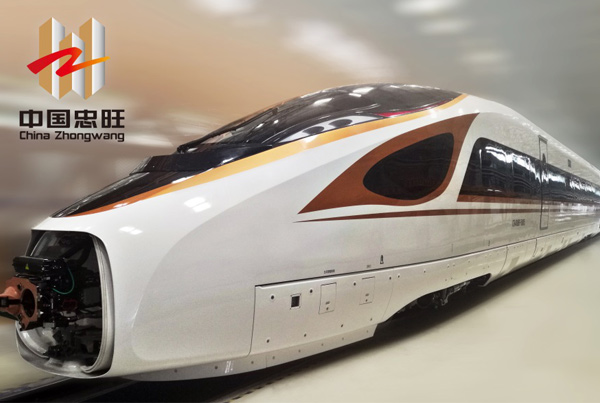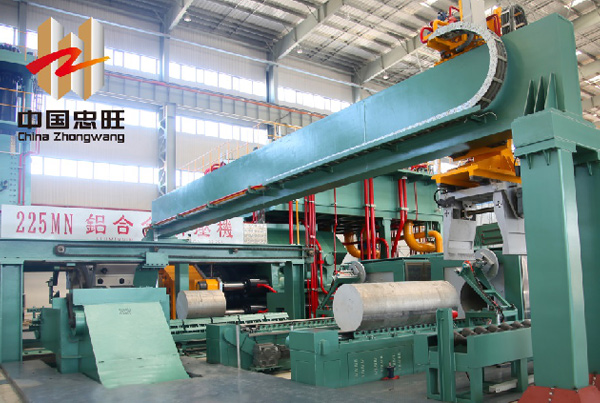China’s high-speed rail industry reached another milestone as the “Fuxing Hao” (Renaissance), a new electric multiple units (“EMU”) bullet train designed by China Railway Corporation, made its debut on the Beijing and Shanghai route on June 26.
The world’s leading next-generation bullet train, the Renaissance EMU, brings a brand-new experience that has been enhanced in speed, safety, and comfort. It is also the first bullet train designed and manufactured entirely in China with full intellectual property rights, including overall design and key technologies related to the body, steering frame, traction, braking and network.
China Zhongwang is a key supplier for aluminium parts of the Renaissance EMU trains. These include a variety of deep-processed aluminium products that meet the high standards in quality and performance. “The aluminium products used in China Standardized EMU trains have passed demanding third-party qualifications, the criteria of which were stricter than those used in Europe, said Mr. Cai Hunan, Vice General Manager of China Zhongwang.

The Renaissance bullet train that used aluminium extrusions supplied by China Zhongwang is being assembled.
China Zhongwang, a key supplier of aluminium alloy products for the body of China’s next-generation bullet train
Trains that travel at speeds of 200km/hour and above require materials that perform particularly well in terms of being lightweight, sealable and corrosion-resistant. With high strength and high ductility while being lightweight and non-corrosive, aluminium alloy is an ideal metal in train body applications. In fact, the bodies of almost all high-speed rail trains currently operating in China are made of aluminium.
Industry experts say high-speed trains that travel at speeds of over 300km/hour must use the lightweight aluminium alloy in the body while those traveling at speeds of over 350km/hour must use aluminium profiles for the entire train compartment except for the chassis.
With tremendous technological innovation in aluminium profiles for train body and deep-processed aluminium parts, China Zhongwang outstands its competitors and becomes a key supplier of aluminum products for the train bodies of the Renaissance EMU.
“We’ve overcome a number of technical challenges in this project. For example, as compared to the CRH380 bullet train, the section of aluminium alloy used in the train bodies of Renaissance EMU are at least 100mm wider, and some parts are 5mm to 20mm taller, which requires high-edged extrusion technologies to manufacture. China Zhongwang’s R&D teams conquered such barriers and successfully delivered highly-qualified products for the Renaissance EMU. Meanwhile, China Zhongwang worked alongside China Railway Rolling Stock Corporation (CRRC) to resolve challenges in the integration of extrusions used in high-speed rails – thanks to China Zhongwang’s exclusive ultra-large 225MN extrusion press, we successfully extruded the ultra large-section extrusions at one time, instead of welding two smaller-section extrusions, further enhanced the safety performance.

China Zhongwang possesses two world-leading ultra-large 225MN extrusion presses.
China Zhongwang has been actively stepping up its presence in China’s EMU and subway projects in recent years. The Company supplies aluminium alloy products for the CRH380 high-speed trains, and also provides high-quality aluminium train bodies of urban subways in multiple cities both at home and abroad. In addition, Zhongwang is one of only a few domestic manufacturers capable of developing and producing large-section extrusion products, such as the broad-plates used on the locomotive of bullet trains that travel at speeds of 300km/hour, 350km/hour and 400km/hour.
Next stop: Eyeing on a broader market
China’s high-speed rail system is in rapid development. By the end of 2016, the operating mileage of China’s high-speed railway exceeded 22,000 km, accounting for over 60% of the total railway mileage around the world.
The commissioning of the bullet train Renaissance has ushered in a new era of rapid expansion for China’s high-speed rail system. The Renaissance EMU delivers substantial improvements over its predecessor, the CRH, including faster speed during continuous operation, longer endurance, greater comfort and safety.
Zheshang Securities estimates the market for the Renaissance EMU at about RMB600 billion, which signifies vast opportunities in the market are yet to be explored.
Zheshang Securities says the Renaissance EMU represents China’s new standard for high-speed rail and the main direction of future development. It estimates that replacing the current 2,586 pairs of the CRH bullet trains with the Renaissance trains would cost around RMB400 billion. Moreover, the “13th Five-Year Plan” decrees that the government will promote infrastructure construction, and it is expected to add 11,000 km of railway, requiring 1,320 additional pairs of Renaissance trains, for a cost of about RMB200 billion.
Renaissance EMU will also see a promising potential in overseas markets. China has made great progress in promoting its high-speed rail overseas. Under the “One Belt, One Road” initiative, a number of progress has been recorded in key overseas high-speed rail projects since 2015, including high-speed rail lines namely Jakarta–Bandung, China-Laos, China-Thailand, and Belgrade-Budapest. China’s high-speed rail has entered markets in Asia, Europe, the Americas and Africa.
Being entirely self-developed and standardised, the Renaissance bullet train would be immune to intellectual property disputes, and is not subject to the rules or stipulations of other parties. This will greatly improve the international competitiveness of China’s high-speed rail products and accelerate its pace of expansion into the global market, according to industry observers.
According to Mr. He Huawu, Chief Engineer of the China Railway Corporation and an academic at the Chinese Academy of Engineering, the China Standardized EMU will be applied in a high-speed rail project in Indonesia and the bullet train Renaissance will become the leading model of China’s high-speed rail in overseas markets.
The bright prospects and huge market potential for China’s high-speed rail should drive development across the industry chain. In the past, Chinese players were not able to produce certain aluminium products such as the aluminium alloy sections used in bullet train cabins. As a result, they had to rely largely on imports, which raised processing and other costs, said Mr. Lu Changqing, Executive Director and President of China Zhongwang. But now China Zhongwang and other Chinese companies are fully capable of manufacturing the high-quality aluminium extrusion products applied in high-speed rail projects. Moreover, processing costs for the aluminium alloy sections used in bullet train cabins are significantly lower while the quality has improved, making "Made in China" more competitive than ever.